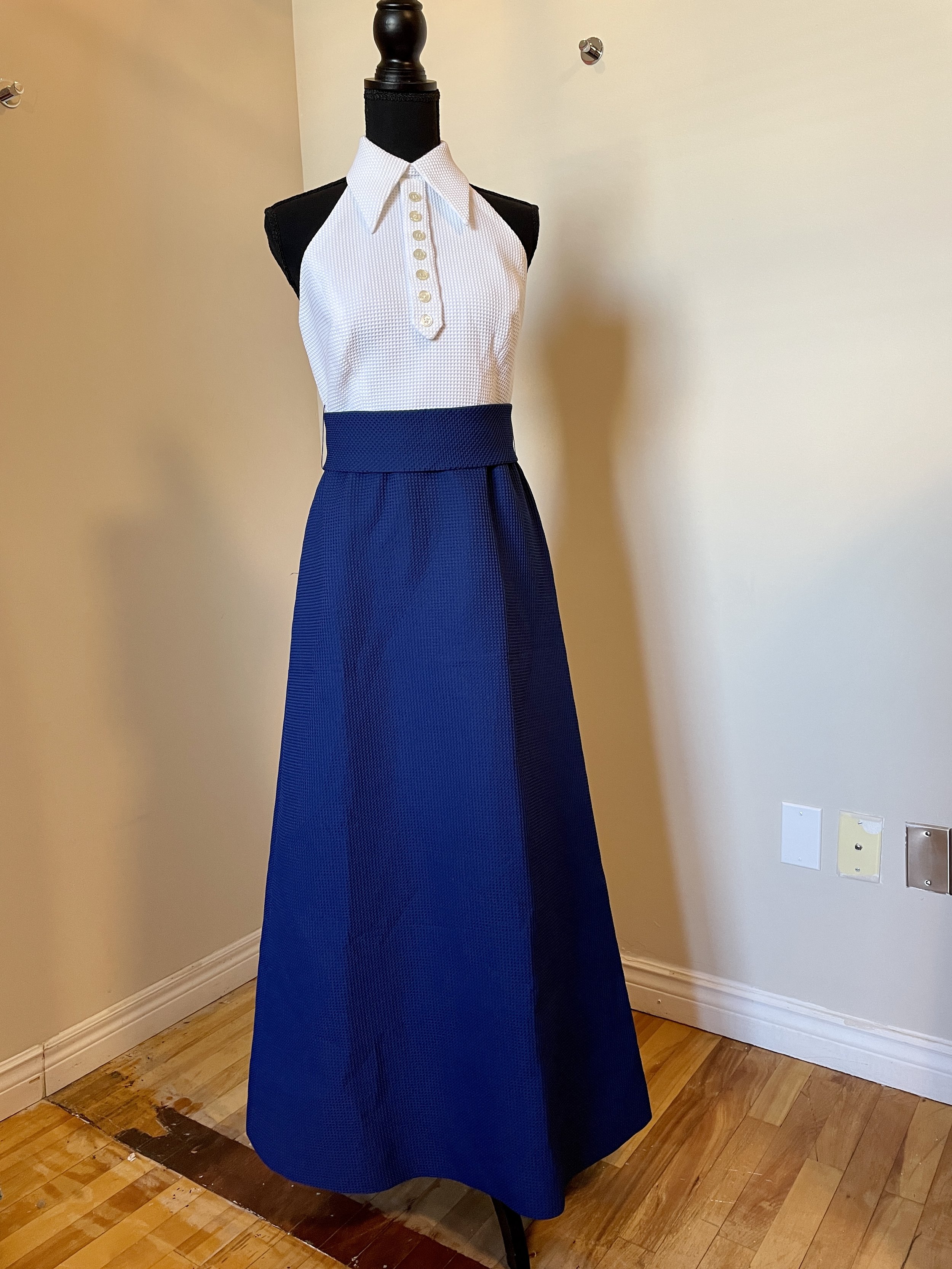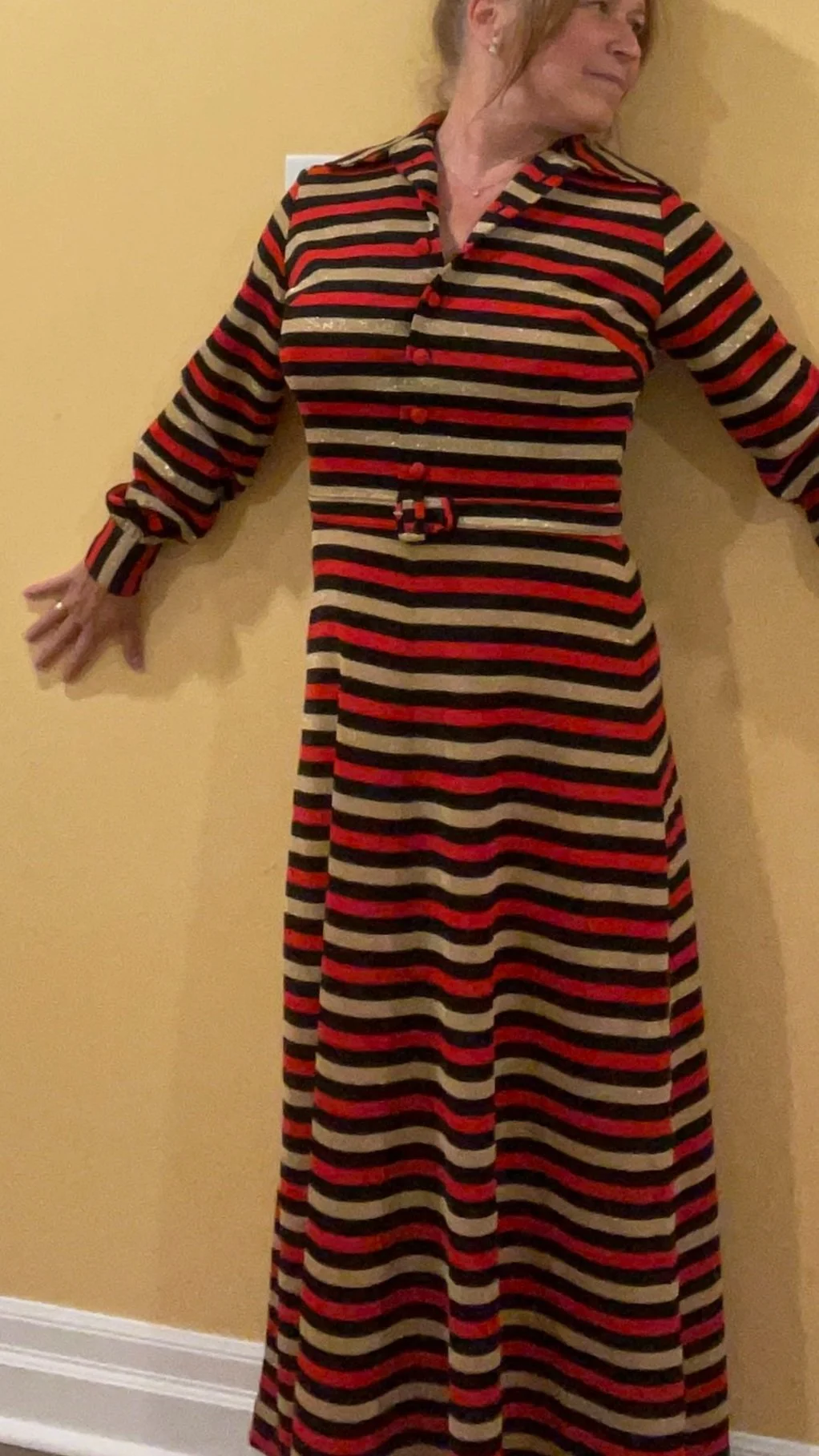1970 - Unveiling a Decade of Style Revolution
1970s wool poncho
Here we have the emerging earth tones, wooden buttons and a cooltwist on the formal opera capes of the past.
As we fasten our vintage seatbelts and zoom into 1970, we find ourselves on the brink of a new era, a year marked by cultural symphonies and a sartorial shift that would echo through time. Speaking of seatbelts, although most cars by now had seat belts, they were not mandatory. If you tried to put a seatbelt on, you would no doubt give up because they were almost always lost in the folds of the car seat and way too difficult to retrieve! In Canada, it wasn't until the mid-70s that seat belts were mandatory in just one province, and in Nova Scotia, it wasn’t until the '80s that seat belts became mandatory. But I digress, back to the year 1970.
In the realm of television, "The Partridge Family" becomes our time capsule. Premiering in the fall of 1970, this musical sitcom not only entertained but also encapsulated the changing dynamics of American families. With Shirley Jones leading the crew, including the heartthrob David Cassidy, the Partridges paved the way for a more unconventional family structure, mirroring the societal shifts of the era. The fashion of both David Cassidy (Keith Partridge) and Susan Dey (Laurie Partridge) was followed by every teenager of the day. Wide-collared shirts, bell bottoms, and an added poncho being the staple. But even though we see the emerging '70s iconic style, you will also see Susan Day, and Shirley Jones for that matter, in cute little mini dresses echoing the '60s. After all, only one year after 1969, you can still imagine that mini skirts, tie-dye patterns and free-flowing silhouettes still lingered as well.
The musical landscape echoed the sentiments of change, with The Beatles' "Let It Be" album released earlier in the year. The iconic rooftop concert in January 1969, depicted in the film of the same name, captured the essence of an era saying its goodbyes. The Beatles were bidding farewell to the '60s, and in doing so, unknowingly ushering in a decade where individual expression would take center stage. Musicians were becoming a little more experimental. Singer-Songwriter teams were starting to emerge. Elton John decked out in a star studded shirt, overalls and platform shoes, with his partner Bernie Taupin made his appearance at the Troubadour in Los Angeles in 1970. Theirs was a different type of music that swept the nation and the world in years to come. Another type of music that got its start in 1970 was disco. The 1970s are famously called the disco era. People were not wearing disco clothes or dancing in disco bars in 1970, but it certainly started here.
1970s Red Fringe Suede Jacket
So let’s talk about color. The color palette of 1970 mirrors a yearning for nature, with earthy tones dominating, reflecting a connection to the land. In the early 1970s, there was a growing environmental movement and increased awareness of ecological issues. This awareness translated into various aspects of life, including fashion. The “back to the earth” movement was also reflected in fabrics. Natural fabrics, such as cotton and linen, gained popularity as people sought clothing that was comfortable, breathable, and in harmony with the environment. This era marked a departure from the synthetic fabrics and bold, artificial colors of the previous decade. The focus on natural, earth-toned fashion was part of a larger cultural shift towards sustainability, mindfulness, and a rejection of the excesses of consumer culture. It's fascinating how fashion often mirrors and responds to the broader societal values and trends of its time. That’s not to say the psychedelic hues of the late '60s didn’t still continue; they did, but it was in 1970 that the shift towards earth tones started.
So, how was the fashion scene rocking in 1970? Picture this: earth tones ruling the stage, but wait, psychedelic bursts still stealing the spotlight. You can see how orange and brown with avocado accents were starting to emerge as the colour combo of the 70s. Wide collars, bell bottoms, and sleeves grooving in sync. While the mini skirt and dress held their sway, the maxi dress and skirt were the new cool kids on the block. Remember the maxi's debut in '67? It stuck around like a favorite riff. Fashion, like a pendulum, swung between extremes, mirroring the political beats of the time. The poncho was still in style but it was becoming cool with pockets and in some cases, a fringe. The youth, fueled by '60s rebellion, embraced sartorial freedom. Amidst lingering dress codes, a sea of change was brewing. More than anything, the youth just wanted to be free, radiating love. As the Partridge Family sang, 'Hello world, here’s a song that we’re singing, C’mon get happy!'"
Stay tuned for my next blog as we delve further into the '70s!












